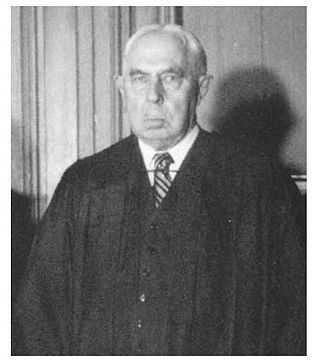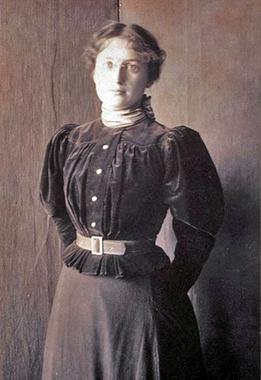Griswold v. Connecticut, 381 U.S. 479 (1965), was a landmark decision of the U.S. Supreme Court in which the Court ruled that the Constitution of the United States protects the liberty of married couples to use contraceptives without government restriction. The case involved a Connecticut "Comstock law" that prohibited any person from using "any drug, medicinal article or instrument for the purpose of preventing conception". The court held that the statute was unconstitutional, and that its effect was "to deny disadvantaged citizens ... access to medical assistance and up-to-date information in respect to proper methods of birth control." By a vote of 7–2, the Supreme Court invalidated the law on the grounds that it violated the "right to marital privacy", establishing the basis for the right to privacy with respect to intimate practices. This and other cases view the right to privacy as "protected from governmental intrusion".

Augustus Noble Hand was a United States district judge of the United States District Court for the Southern District of New York and later was a United States Circuit Judge of the United States Court of Appeals for the Second Circuit. His most notable rulings restricted the reach of obscenity statutes in the areas of literature and contraceptives. He was the older first cousin of famed judge Learned Hand, who served on both courts with his cousin during most of Augustus Hand's tenure.

Anthony Comstock was an American anti-vice activist, United States Postal Inspector, and secretary of the New York Society for the Suppression of Vice (NYSSV), who was dedicated to upholding Christian morality. He opposed obscene literature, abortion, contraception, masturbation, gambling, prostitution, and patent medicine. The terms comstockery and comstockism refer to his extensive censorship campaign of materials that he considered obscene, including birth control advertised or sent by mail. He used his positions in the U.S. Postal Service and the NYSSV to make numerous arrests for obscenity and gambling. Besides these pursuits, he was also involved in efforts to suppress fraudulent banking schemes, mail swindles, and medical quackery.

Mary Coffin Ware Dennett was an American women's rights activist, pacifist, homeopathic advocate, and pioneer in the areas of birth control, sex education, and women's suffrage. She co-founded the National Birth Control League in 1915 together with Jessie Ashley and Clara Gruening Stillman. She founded the Voluntary Parenthood League, served in the National American Women's Suffrage Association, co-founded the Twilight Sleep Association, and wrote a famous pamphlet on sex education and birth control. A famous legal case against her eventually became the catalyst for overturning the Comstock laws.
The Hicklin test is a legal test for obscenity established by the English case R. v Hicklin (1868). At issue was the statutory interpretation of the word "obscene" in the Obscene Publications Act 1857, which authorized the destruction of obscene books. The court held that all material tending "to deprave and corrupt those whose minds are open to such immoral influences" was obscene, regardless of its artistic or literary merit.

United States v. One Package of Japanese Pessaries, 86 F.2d 737, was an in rem United States Court of Appeals case in the Second Circuit involving birth control.
This is a timeline of reproductive rights legislation, a chronological list of laws and legal decisions affecting human reproductive rights. Reproductive rights are a sub-set of human rights pertaining to issues of reproduction and reproductive health. These rights may include some or all of the following: the right to legal or safe abortion, the right to birth control, the right to access quality reproductive healthcare, and the right to education and access in order to make reproductive choices free from coercion, discrimination, and violence. Reproductive rights may also include the right to receive education about contraception and sexually transmitted infections, and freedom from coerced sterilization, abortion, and contraception, and protection from practices such as female genital mutilation (FGM).
The history of condoms goes back at least several centuries, and perhaps beyond. For most of their history, condoms have been used both as a method of birth control, and as a protective measure against sexually transmitted infections such as syphilis, gonorrhea, chlamydia, hepatitis B and more recently HIV/AIDS. Condoms have been made from a variety of materials; prior to the 19th century, chemically treated linen and animal tissue are the best documented varieties. Rubber condoms gained popularity in the mid-19th century, and in the early 20th century major advances were made in manufacturing techniques. Prior to the introduction of the combined oral contraceptive pill, condoms were the most popular birth control method in the Western world. In the second half of the 20th century, the low cost of condoms contributed to their importance in family planning programs throughout the developing world. Condoms have also become increasingly important in efforts to fight the AIDS pandemic.
"Advice to a Friend on Choosing a Mistress" is a letter by Benjamin Franklin dated June 25, 1745, in which Franklin counsels a young man about channeling sexual urges. Due to its licentious nature the letter was not published in collections of Franklin's papers in the United States during the 19th century. Federal court decisions from the mid- to late- 20th century cited the document as a reason for overturning obscenity laws.
An obscenity is any utterance or act that strongly offends the prevalent morality of the time. It is derived from the Latin obscēnus, obscaenus, "boding ill; disgusting; indecent", of uncertain etymology. Generally, the term can be used to indicate strong moral repugnance and outrage in expressions such as "obscene profits" and "the obscenity of war". As a legal term, it usually refers to descriptions and depictions of people engaged in sexual and excretory activity.

The womb veil was a 19th-century American form of barrier contraception consisting of an occlusive pessary, i.e. a device inserted into the vagina to block access of the sperm into the uterus. Made of rubber, it was a forerunner to the modern diaphragm and cervical cap. The name was first used by Edward Bliss Foote in 1863 for the device he designed and marketed. "Womb veil" became the most common 19th-century American term for similar devices, and continued to be used into the early 20th century. Womb veils were among a "range of contraceptive technology of questionable efficacy" available to American women of the 19th century, forms of which began to be advertised in the 1830s and 1840s. They could be bought widely through mail-order catalogues; when induced abortion was criminalized during the 1870s, reliance on birth control increased. Womb veils were touted as a discreet form of contraception, with one catalogue of erotic products from the 1860s promising that they could be "used by the female without danger of detection by the male."

The birth control movement in the United States was a social reform campaign beginning in 1914 that aimed to increase the availability of contraception in the U.S. through education and legalization. The movement began in 1914 when a group of political radicals in New York City, led by Emma Goldman, Mary Dennett, and Margaret Sanger, became concerned about the hardships that childbirth and self-induced abortions brought to low-income women. Since contraception was considered to be obscene at the time, the activists targeted the Comstock laws, which prohibited distribution of any "obscene, lewd, and/or lascivious" materials through the mail. Hoping to provoke a favorable legal decision, Sanger deliberately broke the law by distributing The Woman Rebel, a newsletter containing a discussion of contraception. In 1916, Sanger opened the first birth control clinic in the United States, but the clinic was immediately shut down by police, and Sanger was sentenced to 30 days in jail.

Birth control in the United States is available in many forms. Some of the forms available at drugstores and some retail stores are male condoms, female condoms, sponges, spermicides, and over-the-counter emergency contraception. Forms available at pharmacies with a doctor's prescription or at doctor's offices are oral contraceptive pills, patches, vaginal rings, diaphragms, shots/injections, cervical caps, implantable rods, and intrauterine devices (IUDs). Sterilization procedures, including tubal ligations and vasectomies, are also performed.
The Free Speech League was a progressive organization in the United States that fought to support freedom of speech in the early 20th century. The League focused on combating government censorship, particularly relating to political speech and sexual material. It was a predecessor of the American Civil Liberties Union.
United States obscenity law deals with the regulation or suppression of what is considered obscenity and therefore not protected speech or expression under the First Amendment to the United States Constitution. In the United States, discussion of obscenity typically relates to defining what pornography is obscene, as well as to issues of freedom of speech and of the press, otherwise protected by the First Amendment to the Constitution of the United States. Issues of obscenity arise at federal and state levels. State laws operate only within the jurisdiction of each state, and there are differences among such laws. Federal statutes ban obscenity and child pornography produced with real children. Federal law also bans broadcasting of "indecent" material during specified hours.
The obscenity trial over the publication of James Joyce's Ulysses in The Little Review, an American literary magazine, occurred in 1921 and effectively banned publication of Joyce's novel in the United States. After The Little Review published the "Nausicaa" episode of Ulysses in the April 1920 issue of the magazine, the New York Society for the Suppression of Vice instigated obscenity charges against Little Review editors Margaret Caroline Anderson and Jane Heap. The editors were found guilty under laws associated with the Comstock Act of 1873, which made it illegal to send materials deemed obscene through the U.S. Mail. Anderson and Heap incurred a $100 fine, and were forced to cease publishing Ulysses in The Little Review.
Rabe v. Washington, 405 U.S. 313 (1972), was a decision by the United States Supreme Court involving the application of obscenity laws and criminal procedure to the states. On 29 August 1968, William Rabe, the manager of a drive-in movie theater in Richland, Washington, was arrested on obscenity charges for showing the film Carmen, Baby. Due to First Amendment concerns, the local court convicted Rabe not on the basis that the film as a whole was obscene, but that exhibiting it in a drive-in theater was. The Supreme Court reversed the conviction holding that the citizens of Washington had no notice under the Sixth Amendment that the place where a film was shown was an element of the offense.
Ginzburg v. United States, 383 U.S. 463 (1966), was a decision by the United States Supreme Court involving the application of the First Amendment to Federal obscenity laws. One of a trio of cases, Ginzburg was part of the Supreme Court's attempt to refine the definitions of obscenity after the landmark 1957 case Roth v. United States.
Family Limitation is a pamphlet written by American family planning activist, educator, writer, and nurse Margaret Sanger that was published in 1914. It was one of the first guides to birth control published in the United States. The 16-page pamphlet details information on, and ingredients for, various contraceptive methods and included illustrations and instructions for use. After the pamphlet was released, Sanger was forced to flee the United States to Britain to avoid prosecution under federal anti-obscenity laws, the Comstock Act, which prohibited disseminating information about contraception.








